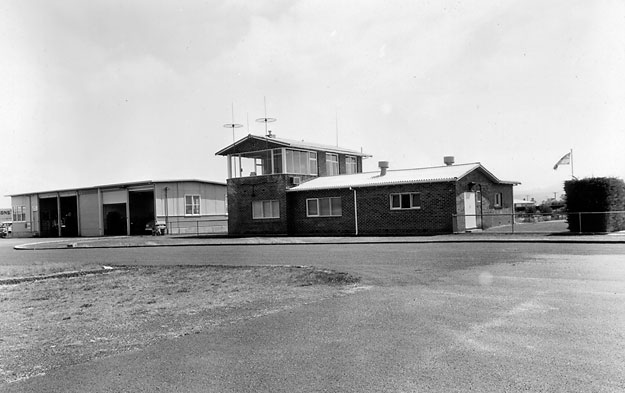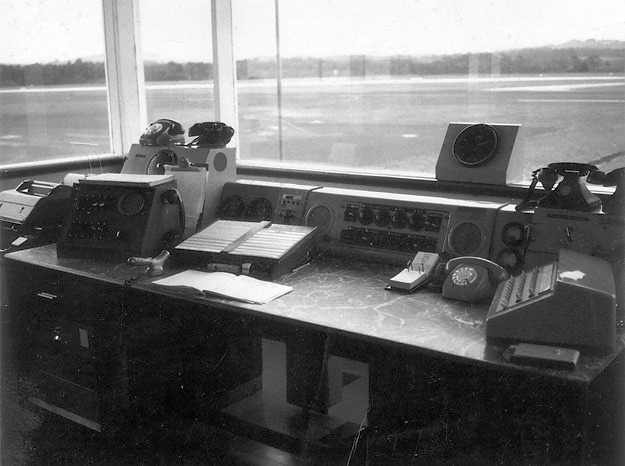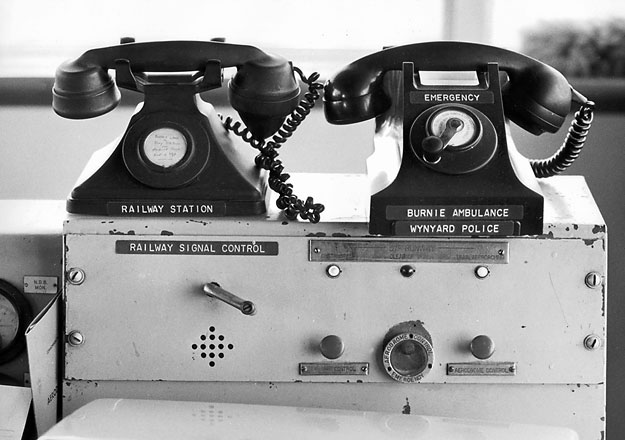
Wynyard
Airport, on Tasmania's north-western coast, was quite unusual in that it was one
of the few airports in the world to have a railway crossing on a runway (click
here to see photos). Prior to 1991, the rail crossing was controlled from
the Wynyard Flight Service Unit (FSU).
The photo above shows the Wynyard FSU as it looked in the 1960s, viewed from the south (airside). Perhaps because of the rail crossing, the Wynyard FSU was not subject to the general edict that FSUs should not overlook the movement area, and the Flight Service Officers had a good view over the airport. At left in the photo above is the Airport Fire Station, closed with the general contraction of airport fire services in the early 1990s, whilst at right the Civil Air Ensign flutters proudly from the flagpole.

The
photos above and below show the interior of the Wynyard FSU as it looked in the 1960s. There
are various communications consoles on the desk, with the one at centre rear being
of particular interest. This console was originally installed in the second Essendon Control Tower and is now one of
the key exhibits in the Airways Museum. Roll your cursor over the image above to highlight the former Essendon Tower console. Roll your cursor over the image below to identify other items of equipment.
Also of considerable interest is the consolette at far right rear, shown in detail in the 1971 photo beneath, which controlled the railway crossing signalling.

The
three lights at top right of the railway signalling consolette, below, indicated, from left to right, that
the runway was obstructed by a train, that the runway was clear of trains, and
that a train was approaching. Flight Service could either warn approaching aircraft
that a train was obstructing the runway, or stop the train by triggering a signal
on the track. The two buttons either side of the brass ring at right bottom of
the consolette are the emergency stop signal buttons for the railway and the runway.

When
the Wynyard FSU was closed on 14 December 1990 as part of the programme of consolidation
of Flight Service functions to the major Centres, the railway signalling function
was also transferred to Melbourne. However, new consoles due to be installed in
the Melbourne FSC in December 1991 did not have the signalling functionality,
so an alternative was sought.
CAA Flying Operations Inspector Kevin Smith (himself formerly an Air Traffic Controller) suggested a system similar to that used in Gisborne, New Zealand, one of the few places in the world with a similar railway crossing. Such a system was designed and installed in 1992.
The signal system relied on banks of green 'vertical' (runway aligned) lights to indicate that the runway was clear for aircraft operations, and red horizontal lights to indicate that a train was approaching or on the runway.
The system detected approaching trains in sufficient time (approximately 50 seconds) for aircraft committed on approach to land safely or go around, or for aircraft taking off to continue the takeoff safely. Trains approaching the detection zone faced a green signal until entering the detection zone when the signal changed momentarily to red. In the meantime, a signal was sent to the runway lights, changing the displayed array from green to red.
When the system's internal checking confirmed that the runway signal lights had changed, the train signal would also change back to green.
Following a long decline in rail traffic, the north-west line through Wynyard was closed in early 2005 and the associated signal light system was decommissioned on 19 March that year, bringing to an end this unique air/rail crossing.
(Photos:
CAHS collection)
Back
to the main Airports and Aerodromes
index
Back to the main Air Traffic Services index
If
this page appears without a menu bar at top and left, click
here